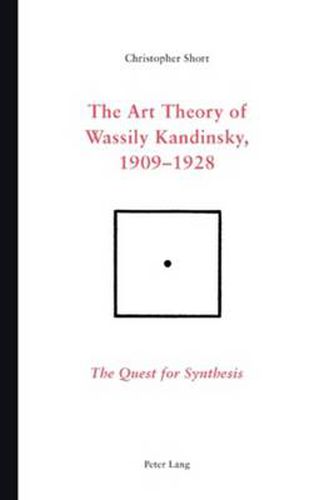Readings Newsletter
Become a Readings Member to make your shopping experience even easier.
Sign in or sign up for free!
You’re not far away from qualifying for FREE standard shipping within Australia
You’ve qualified for FREE standard shipping within Australia
The cart is loading…






This title is printed to order. This book may have been self-published. If so, we cannot guarantee the quality of the content. In the main most books will have gone through the editing process however some may not. We therefore suggest that you be aware of this before ordering this book. If in doubt check either the author or publisher’s details as we are unable to accept any returns unless they are faulty. Please contact us if you have any questions.
Kandinsky’s theory of art has usually been treated as little more than a guide to help our understanding of his paintings. In contrast, this book attends primarily to the artist’s writings on art; thus his art theory is treated on its own terms. Drawing on the diverse literature that has been written on Kandinsky’s art and theory, the author demonstrates that while many different perspectives on his work have been identified, none holds the ‘key’ to that work. Instead, the book shows Kandinsky’s method in his writings to be highly eclectic, resulting in an exciting and challenging variety of content (a description that also applies, as a postscript to the book shows, to his method in painting). Kandinsky, however, transcended this diversity and consistently sought evidence of the unity of all things: something that would be realised through his understanding of the term ‘synthesis’. The book follows Kandinsky’s fascinating attempts to establish synthesis (not only in art but also in other disciplines including science, mathematics, law and politics) in his key theoretical publications: On the Spiritual in Art (1911) and Point and Line to Plane (1926). The result is a new and innovative understanding of both Kandinsky’s art theory and his art.
$9.00 standard shipping within Australia
FREE standard shipping within Australia for orders over $100.00
Express & International shipping calculated at checkout
This title is printed to order. This book may have been self-published. If so, we cannot guarantee the quality of the content. In the main most books will have gone through the editing process however some may not. We therefore suggest that you be aware of this before ordering this book. If in doubt check either the author or publisher’s details as we are unable to accept any returns unless they are faulty. Please contact us if you have any questions.
Kandinsky’s theory of art has usually been treated as little more than a guide to help our understanding of his paintings. In contrast, this book attends primarily to the artist’s writings on art; thus his art theory is treated on its own terms. Drawing on the diverse literature that has been written on Kandinsky’s art and theory, the author demonstrates that while many different perspectives on his work have been identified, none holds the ‘key’ to that work. Instead, the book shows Kandinsky’s method in his writings to be highly eclectic, resulting in an exciting and challenging variety of content (a description that also applies, as a postscript to the book shows, to his method in painting). Kandinsky, however, transcended this diversity and consistently sought evidence of the unity of all things: something that would be realised through his understanding of the term ‘synthesis’. The book follows Kandinsky’s fascinating attempts to establish synthesis (not only in art but also in other disciplines including science, mathematics, law and politics) in his key theoretical publications: On the Spiritual in Art (1911) and Point and Line to Plane (1926). The result is a new and innovative understanding of both Kandinsky’s art theory and his art.